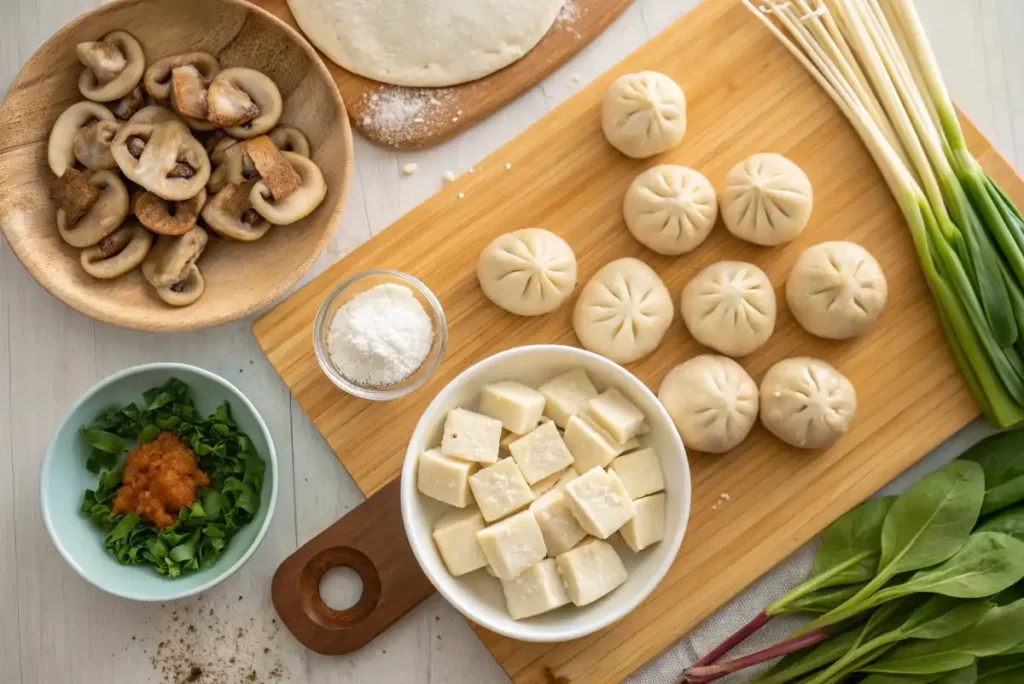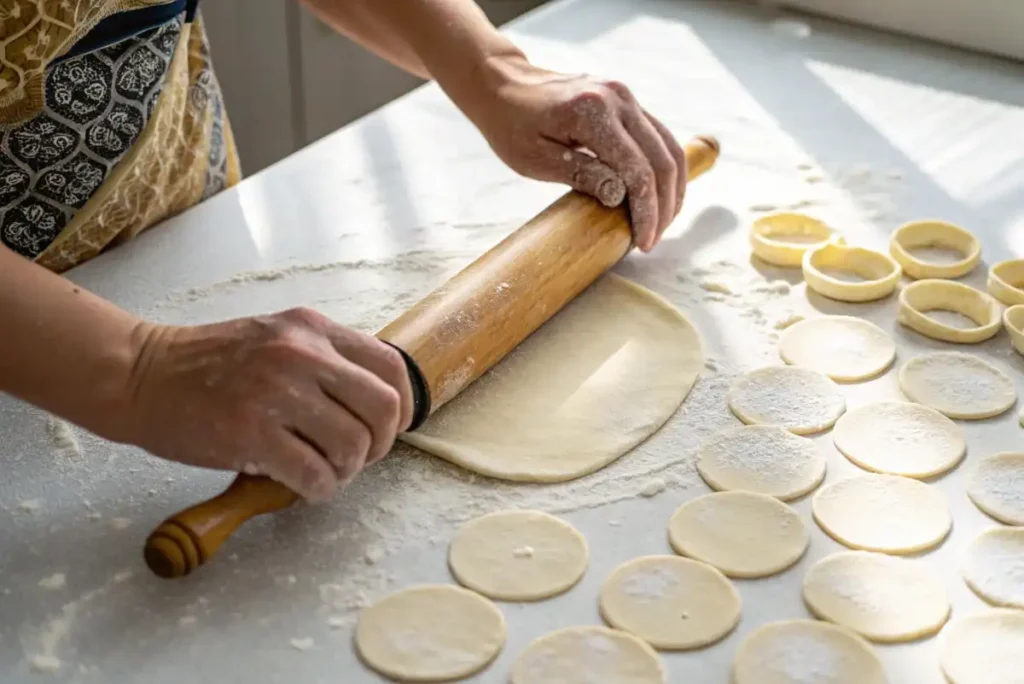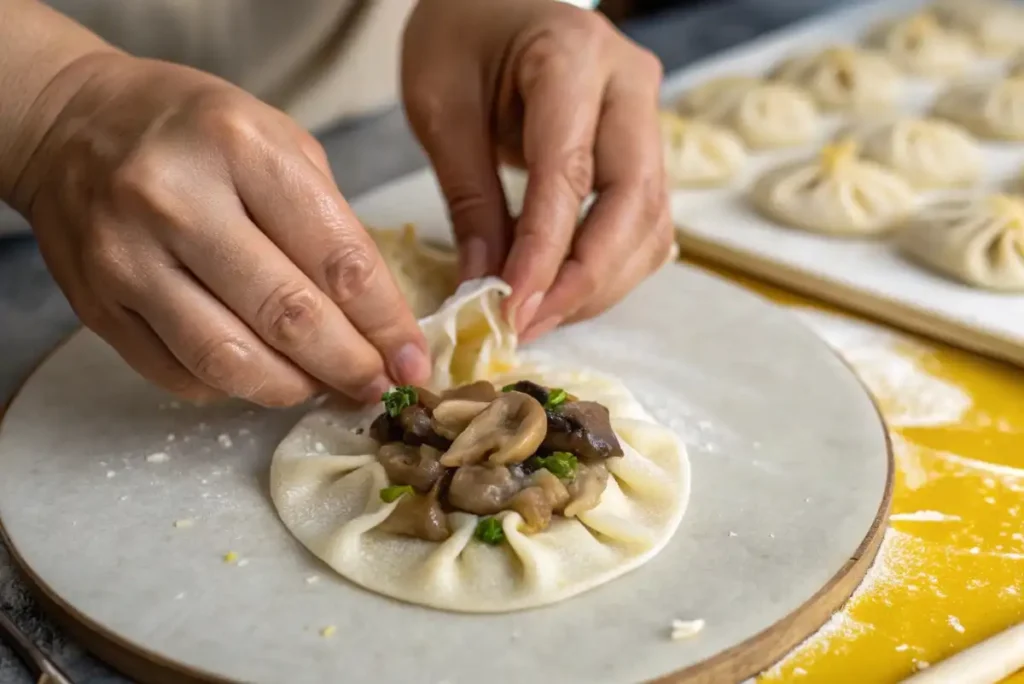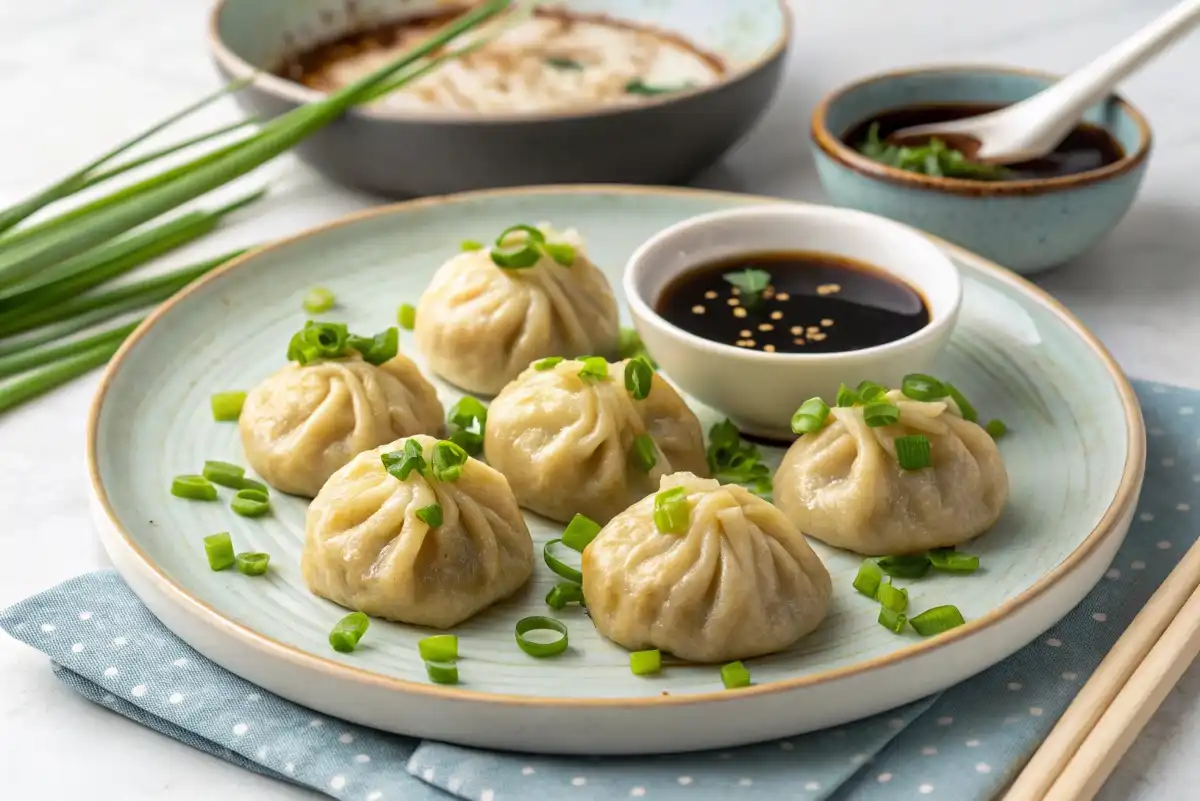Explore how to make vegan soup dumplings, from crafting the dough to perfecting the broth, for a delicious plant-based treat.
Introduction
Vegan soup dumplings are an exciting twist on the classic Xiao Long Bao, which traditionally feature meat fillings and an intricate, soupy interior. In this plant-based version, every dumpling offers a burst of savory broth, fresh vegetables, and protein-packed alternatives without using any animal products. Therefore, you can enjoy all the comfort and flavor of traditional soup dumplings in a way that aligns with a compassionate and eco-friendly lifestyle. In addition, this guide will walk you through each step, from making the dough to assembling the final dumplings, ensuring a delightful experience in your kitchen.
Whether you are new to plant-based cooking or a seasoned vegan, these soup dumplings are perfect for boosting your repertoire of healthy meals. Furthermore, this recipe highlights simple methods to replicate that signature soupy sensation, all while maintaining the dumplings’ delicate texture. Read on to discover how to make these delicious vegan soup dumplings at home, along with tips, variations, nutritional insights, and answers to common questions.
Table of Contents
The Rise of Vegan Soup Dumplings
Vegan soup dumplings have risen to popularity as more people embrace plant-based diets. Consequently, chefs around the globe experimented with different ingredients, searching for ways to recreate that iconic burst of hot, flavorful liquid inside each dumpling. Over time, the demand for meatless versions grew, and these tasty, broth-filled vegan dumplings emerged as a culinary innovation.
A Modern Take on Traditional Xiao Long Bao
The original Xiao Long Bao dates back centuries in Chinese cuisine. Typically, pork or other meats are encased in a thin wrapper, complete with a gelatinized broth that liquefies once steamed. However, the vegan soup dumpling trades animal-based fillings for savory vegetables, mushrooms, and plant-based gels, meeting the desires of those who appreciate cruelty-free choices.
Vegan Dumplings in the U.S.
In the United States, demand for vegan soup dumplings skyrocketed as grocery stores and restaurants started to offer more creative vegan meals. Many people who once hesitated to try dumplings with pork fillings now enjoy these delicate bites of flavor without compromising their ethical or dietary preferences. Therefore, vegan soup dumplings found a steady presence on menus, in food trucks, and as a DIY cooking project at home.
Looking for more plant-based ideas? Check out our Vegan Lunch Ideas for additional inspiration that aligns with your meatless lifestyle.
Key Ingredients for Vegan Soup Dumplings

Achieving the same mouthwatering effect as traditional soup dumplings relies on selecting the right combination of plant-based elements. Therefore, you want components that replicate the savory, gelatinous broth and the hearty texture usually attributed to meat.
Plant-Based Broth Gel
The hallmark of any soup dumpling is the pocket of broth that bursts when you bite into it. For vegan soup dumplings, create this “soup” with vegetables, mushrooms, and aromatic spices. Simmer your chosen ingredients in water or vegetable stock, then thicken and set the liquid using a gelling agent such as agar-agar or konjac powder. In addition, consider using kombu (dried kelp) or dried shiitake mushrooms to add extra umami flavor.
Savory Filling Components
- Mushrooms: Shiitake, portobello, or button mushrooms bring a deep, meaty texture.
- Tofu or Tempeh: Cubed or crumbled, they absorb flavors and offer valuable protein.
- TVP (Textured Vegetable Protein): Acts as a chewy, high-protein filler that soaks up seasonings.
Aromatics & Seasonings
- Ginger: For a zingy warmth.
- Garlic & Onions: A classic base, releasing sweet and savory notes.
- Soy Sauce or Tamari: Enhances the dumplings’ depth of taste.
- Sesame Oil: Adds a rich, nutty dimension.
Optional Veggie Add-Ons
- Carrots: Minced carrots add color and a slight sweetness.
- Bok Choy or Spinach: Provides fresh, leafy contrast.
- Green Onions: Offers a mild, bright flavor.
Tip: If you enjoy exploring vegan soups in general, you might also appreciate our Vegan Chicken Noodle Soup for another comforting bowl packed with flavor.
Crafting the Vegan Dumpling Dough
The wrapper is integral to the experience of vegan soup dumplings. In fact, a tender-yet-sturdy dough is essential for holding the precious soup inside.
Dumpling Dough Basics
A standard dumpling dough consists of flour and water. However, you must pay attention to the ratio and technique:
- Flour Type: All-purpose flour is commonly used due to its moderate protein content.
- Water Temperature: Warm or hot water often yields a softer dough, though cold water can make a chewier wrapper.
Rolling and Resting

- Combine Flour and Water: In a mixing bowl, gradually add warm water to the flour, stirring to form a shaggy dough.
- Knead Thoroughly: Knead the dough on a lightly floured surface for about 8-10 minutes until smooth.
- Rest the Dough: Cover the dough with a damp towel or plastic wrap. Let it rest for at least 30 minutes. Therefore, the gluten relaxes and creates a more pliable texture.
Gluten-Free Alternatives
If you follow a gluten-free diet, consider using a blend of rice flour and tapioca starch. However, keep in mind that gluten-free dough can be more delicate, so carefully adjust the water ratio and kneading time to achieve the desired elasticity.
Creating a Flavorful Vegan Soup Filling
The soup filling includes both the jellied broth (which melts into liquid when steamed) and a tasty combination of tofu, mushrooms, or vegetables.
Making Vegan Broth Gel
- Simmer Aromatic Base: In a pot, add water or vegetable stock, sliced ginger, dried shiitake mushrooms, onions, and a pinch of salt. Bring to a gentle boil, then lower the heat to simmer for 15-20 minutes.
- Strain and Season: Remove solid ingredients. Season the strained broth with soy sauce, sesame oil, and a dash of white pepper.
- Use a Gelling Agent: Dissolve agar-agar or konjac powder into the hot broth according to the package instructions. Stir thoroughly to prevent clumps.
- Cool and Set: Pour the mixture into a shallow dish, let it cool, then refrigerate until firm. Cut the gel into small cubes.
Assembling the Filling
- Mushroom Preparation: Finely chop the mushrooms, then sauté them in a bit of oil with garlic and onions until tender.
- Protein Addition: Stir in crumbled tofu, tempeh, or TVP. Season with soy sauce and a touch of sugar to balance the flavors.
- Combine with Broth Cubes: Once your soup gel is set, cut it into tiny squares. Gently fold them into the mushroom-tofu mix, ensuring every dumpling receives some of that magical soupy goodness.
Step-by-Step Assembly of Vegan Soup Dumplings
Assembling vegan soup dumplings may seem daunting. However, breaking down the process into smaller steps makes it approachable and fun.
Setting Up Your Dumpling Station
- Dough Prep: Divide the rested dough into small pieces (around 1 inch in diameter).
- Rolling Each Wrapper: Use a rolling pin to flatten each piece into a thin, circular wrapper, about 3-4 inches wide. Keep extra pieces covered to prevent them from drying out.
- Filling Bowls: Have your cooled filling ready in one bowl and a small bowl of water for sealing.
Filling & Folding

- Add the Filling: Place a spoonful of the mushroom mixture and a few cubes of soup gel in the center of each wrapper.
- Moisten the Edge: Dip your finger in water and wet the outer rim of the wrapper to help seal.
- Gather and Pleat: Pick up the sides of the wrapper, pleating around the filling. Pinch the top to create a tight seal.
- Check for Leaks: Gently press to ensure there are no tiny holes where liquid could escape during steaming.
Arranging the Dumplings
Line a tray or plate with parchment paper and lightly dust with flour. Place each assembled dumpling on the tray, ensuring they do not stick together. Therefore, when you move them to the steamer, each dumpling remains intact and easy to transfer.
Cooking Methods & Techniques
Steaming is the traditional way to cook soup dumplings. In addition, other methods like pan-frying can offer unique results, but steaming ensures the soup remains inside.
Steaming Vegan Soup Dumplings
- Set Up a Steamer: A bamboo steamer or metal steamer basket works well. Line the steamer with parchment or cabbage leaves to prevent sticking.
- Bring Water to a Boil: In a wok or pot, heat a few inches of water to a rolling boil.
- Steam Dumplings: Arrange your dumplings in a single layer, leaving room between them. Steam for about 7-10 minutes.
- Check Doneness: The wrappers should look slightly translucent. Therefore, you know they are ready when the dough is cooked through and the filling is hot.
Alternate Methods
- Pan-Frying: Heat a small amount of oil in a non-stick skillet. Add dumplings and cook until the bottoms are lightly browned. Then, pour in a splash of water, cover, and steam until the wrappers are cooked.
- Boiling: While less common for soup dumplings, you can gently boil them in water or broth. However, be cautious as the agitation may lead to breakage.
Tips and Variations for Vegan Soup Dumplings
Vegan soup dumplings are incredibly adaptable. Therefore, you can try different textures and taste profiles by modifying the filling or dipping sauces.
Flavor Enhancements
- Fresh Herbs: Add cilantro or chives for a burst of color and freshness.
- Spicy Kick: Introduce chili flakes or a small amount of chili oil for heat.
- Tangy Twist: Mix a bit of rice vinegar into your mushroom filling for a subtle sour note.
Dipping Sauce Ideas
- Classic Soy-Vinegar: Blend soy sauce, black vinegar, and finely chopped ginger.
- Peanut Sauce: Create a creamy dip by combining peanut butter, soy sauce, and hot water.
- Chili-Garlic: Mix chili paste, garlic, sugar, and soy sauce for a zesty concoction.
Try pairing your dumplings with a warm beverage. Our Lemongrass Tea post offers a soothing option to complement the dumplings’ savory flavors.
Common Mistakes and How to Avoid Them
Despite careful planning, a few pitfalls can occur during the preparation of vegan soup dumplings. Here are some frequent issues and solutions:
- Leaks or Breaks
- Overfilling or using dough that is too thin often results in tears. Therefore, measure the filling carefully and check for any holes before steaming.
- Rubbery Wrappers
- Overcooking dumplings or kneading the dough excessively can lead to tough wrappers. Keep an eye on the steaming time and allow the dough to rest properly.
- Bland Taste
- Under-seasoning the broth or filling may yield uninspiring flavors. In addition, taste-test your filling before final assembly to ensure it has enough spices.
Serving Suggestions and Pairings
Vegan soup dumplings can be enjoyed as a hearty appetizer or a centerpiece of a plant-based feast. Therefore, you can serve them with light side dishes and refreshing drinks for a balanced meal.
Recommended Side Dishes
- Asian-Inspired Salads: A simple cucumber salad or tangy slaw complements the rich, savory dumplings.
- Stir-Fried Greens: Bok choy or spinach stir-fried with garlic can bring a nutritious element to the table.
Beverage Pairings
- Herbal Teas: Try a cup of fragrant Chrysanthemum Tea to soothe the palate.
- Light Soups: A small serving of miso or veggie broth can be a great starter alongside dumplings.
Nutritional Considerations
These vegan soup dumplings offer a nutritious alternative to meat-filled counterparts. They contain protein-rich tofu or mushrooms, plus vitamins from vegetables.
| Nutrient (per 100g) | Approx. Amount |
|---|---|
| Calories | 180 kcal |
| Protein | 6 g |
| Carbohydrates | 27 g |
| Fat | 4 g |
| Fiber | 2 g |
| Sodium | 350 mg |
| Calcium | 30 mg |
| Iron | 2 mg |
Values may vary depending on specific brands, filling ingredients, and wrappers.
Recipe: Vegan Soup Dumplings
H3: Ingredients
For the Dough
- 3 cups all-purpose flour
- 1 cup warm water (approx.)
- ½ teaspoon salt (optional)
For the Soup Gel
- 4 cups vegetable stock or water
- 6 dried shiitake mushrooms (rehydrated if desired)
- 1 onion, quartered
- 3 slices of fresh ginger
- 2 tablespoons soy sauce (or tamari for gluten-free)
- 1 teaspoon sesame oil
- 1 tablespoon agar-agar (adjust according to package instructions)
For the Filling
- 1 tablespoon oil (e.g., canola or vegetable)
- 1 cup finely chopped fresh mushrooms (e.g., shiitake or button)
- 1 cup crumbled tofu or tempeh
- 2 cloves garlic, minced
- 1 teaspoon grated ginger
- 2 tablespoons soy sauce
- 1 teaspoon sugar or sweetener of choice
- Cubed broth gel (from above)
Step-by-Step Cooking Instructions
- Prepare the Dough
- In a bowl, mix flour and optional salt.
- Gradually pour in warm water while stirring, forming a shaggy dough.
- Knead on a floured surface for about 8 minutes until smooth.
- Cover and let it rest for at least 30 minutes.
- Make the Soup Gel
- In a pot, add vegetable stock or water, rehydrated mushrooms, onion, and ginger.
- Bring to a boil, reduce heat, and let it simmer for 15-20 minutes.
- Strain out the solids, then stir in soy sauce and sesame oil.
- Whisk agar-agar into the hot liquid until fully dissolved.
- Pour into a shallow dish to cool and set in the refrigerator. Cut into small cubes.
- Cook the Filling
- Heat oil in a pan over medium heat. Add mushrooms, garlic, and ginger. Sauté until softened.
- Add crumbled tofu, soy sauce, and sugar. Cook for several more minutes, stirring frequently.
- Cool the filling, then gently fold in the broth gel cubes.
- Form the Dumplings
- Divide the dough into 12-16 small balls. Roll each ball into a thin circle.
- Place a spoonful of the filling in the center.
- Wet the wrapper’s edge with water, then pleat and seal.
- Set dumplings on a parchment-lined tray.
- Steam the Dumplings
- Line a steamer basket with parchment paper or cabbage leaves.
- Arrange dumplings so they do not touch.
- Steam for 7-10 minutes until wrappers appear translucent.
- Serve hot with your favorite dipping sauce.
Frequently Asked Questions (FAQs)
What is a substitute for gelatin in soup dumplings?
A popular substitute is agar-agar, which is derived from seaweed. Another option is konjac powder. Both gelling agents help create that firm broth cube essential for vegan soup dumplings. Therefore, you can still enjoy the classic soupy interior without any animal products.
Can you buy vegetarian soup dumplings?
Yes, several grocery stores and specialty shops offer pre-made vegetarian soup dumplings. You can also find vegan soup dumplings in certain Asian markets. However, availability may vary by region. Therefore, it can be more fun and cost-effective to make them from scratch at home, guaranteeing fresh ingredients and total control over flavors.
Are vegan soup dumplings authentic?
Authenticity often depends on context. While the traditional Xiao Long Bao includes meat, vegan soup dumplings honor the technique and structure but replace the filling with plant-based ingredients. This modern adaptation respects culinary tradition while embracing evolving dietary trends.
How do I freeze leftover dumplings?
Place uncooked dumplings on a tray so they do not stick together. Freeze them until solid, then transfer to a sealed container. When you want to cook them, you can steam or pan-fry from frozen, though you might need a few extra minutes of cooking time.
What do vegans eat for lunch?
Vegans often enjoy meals that incorporate a variety of grains, legumes, and vegetables. For instance, you could pair these vegan soup dumplings with salads or bean-based side dishes. If you need fresh meal ideas, our post on What Do Vegans Eat for Lunch? offers more tips for a balanced midday meal.
Conclusion
Vegan soup dumplings provide a compelling way to savor the comforting pleasure of Xiao Long Bao without using any animal products. In addition, they showcase the versatility of mushrooms, tofu, and other plant-based options, proving that flavor and texture need not be compromised. By carefully crafting a jellied broth, assembling a hearty filling, and mastering a reliable dumpling dough, you can enjoy a delicious soup-filled bite with every morsel.
Ultimately, these dumplings highlight how global food traditions can adapt to meet changing tastes and dietary requirements. Therefore, we encourage you to experiment with your favorite vegetables, sauces, and seasoning to customize the dish according to your preferences. Happy cooking, and may your vegan soup dumplings turn out perfectly plump and soul-soothing!

